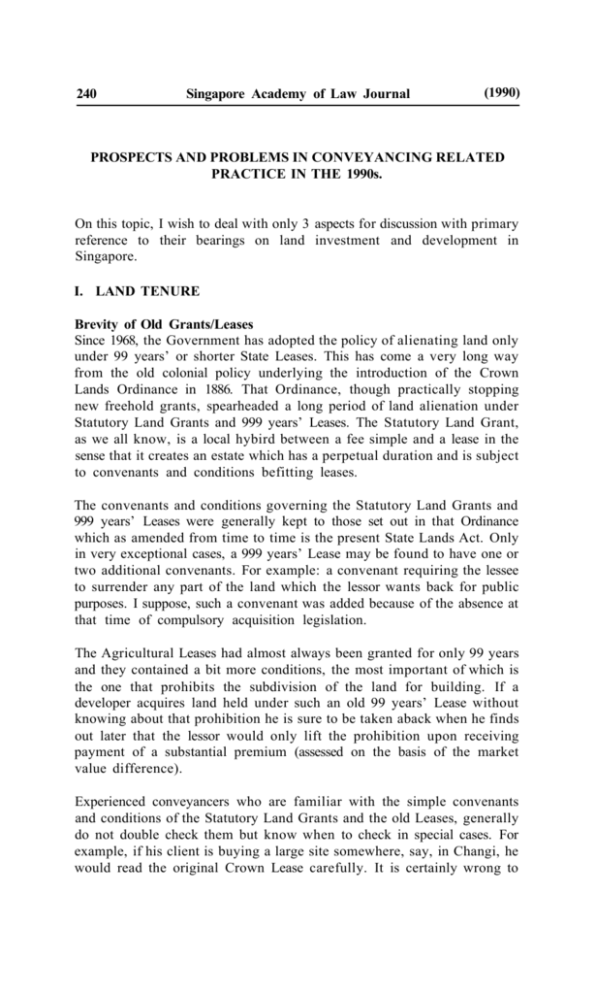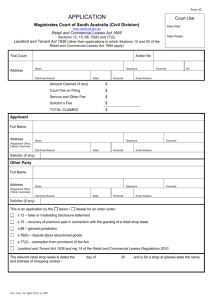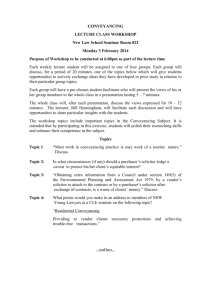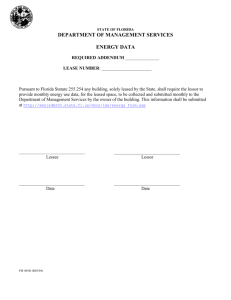View Article - Singapore Academy of Law
advertisement

240 Singapore Academy of Law Journal (1990) PROSPECTS AND PROBLEMS IN CONVEYANCING RELATED PRACTICE IN THE 1990s. On this topic, I wish to deal with only 3 aspects for discussion with primary reference to their bearings on land investment and development in Singapore. I. LAND TENURE Brevity of Old Grants/Leases Since 1968, the Government has adopted the policy of alienating land only under 99 years’ or shorter State Leases. This has come a very long way from the old colonial policy underlying the introduction of the Crown Lands Ordinance in 1886. That Ordinance, though practically stopping new freehold grants, spearheaded a long period of land alienation under Statutory Land Grants and 999 years’ Leases. The Statutory Land Grant, as we all know, is a local hybird between a fee simple and a lease in the sense that it creates an estate which has a perpetual duration and is subject to convenants and conditions befitting leases. The convenants and conditions governing the Statutory Land Grants and 999 years’ Leases were generally kept to those set out in that Ordinance which as amended from time to time is the present State Lands Act. Only in very exceptional cases, a 999 years’ Lease may be found to have one or two additional convenants. For example: a convenant requiring the lessee to surrender any part of the land which the lessor wants back for public purposes. I suppose, such a convenant was added because of the absence at that time of compulsory acquisition legislation. The Agricultural Leases had almost always been granted for only 99 years and they contained a bit more conditions, the most important of which is the one that prohibits the subdivision of the land for building. If a developer acquires land held under such an old 99 years’ Lease without knowing about that prohibition he is sure to be taken aback when he finds out later that the lessor would only lift the prohibition upon receiving payment of a substantial premium (assessed on the basis of the market value difference). Experienced conveyancers who are familiar with the simple convenants and conditions of the Statutory Land Grants and the old Leases, generally do not double check them but know when to check in special cases. For example, if his client is buying a large site somewhere, say, in Changi, he would read the original Crown Lease carefully. It is certainly wrong to 2 S.Ac.L.J. Part II Conveyancing Related Practice 241 assume that the general practice is not to check the original grants or leases. Recent Leases Containing Elaborate Provisions The recent 99 years’ or shorter State Leases invariably contain much more convenants and conditions which are not always the same. One can only find out what they are from reading the particular Lease, on a case to case basis. A solicitor acting for a client who is negotiating with the Land Office for obtaining a new State Lease, should carefully examine and advise his clients on the contents of the draft lease proposed by the Land Office. When acting for a purchaser who is to acquire a title under such a State Lease, the solicitor should check whether it contains any special or unusual conditions which may adversely affect his client’s interest. One would not be surprised to find, in some cases, that the lessor’s consent is required for the sale or that the lessor is entitled to call for the surrender of the lease in certain circumstances. In cases where the Government uses statutory agencies (such as JTC and URA) to alienate land for various sorts of development, the leases granted to the private sector may either be direct State leases or indirect subleases (such as the JTC leases). These leases have very elaborate provisions which appear to be modelled on private commercial leases. It goes without saying that investigation of title necessarily requires perusing those leases without fail. I will take an example. As regards a URA project, normally the lessee requires an unrestricted right of disposal after the completion of the project (excepting the area the lessee has to retain). But, in some cases, the lessee’s right of disposal is made subject to the lessor’s consent throughout the duration of the lease. Conveyancer’s Duty In a recent matter, while a purchaser of a URA project was prepared and happy to accept such a restriction, his banker intending to finance the purchase was not willing to accept a mortgage on that leasehold title because the restriction could adversely affect the practical enforceability of the security. Eventually, URA agreed to certain amendments in that case. A solicitor acting for an intending mortgagee in such a case would have failed in carrying out his duty if he had not examined the contents of the State Lease. It is not correct to assume that there is little room for bargaining with the 242 Singapore Academy of Law Journal (1990) Land Office or a statutory agency for varying the provisions of Leases. In any event, a solicitor’s duty is to fully inform and advise his client and it is for the client to decide whether certain adverse terms and conditions would nevertheless be acceptable to him. More and more State leases and statutory agencies’ subleases are bound to be granted in future. All conveyancers should make it their duty to check the terms and conditions of those leases and should guide their clients in negotiating with the relevant authorities so that hopefully the leases would contain provisions which better balance the interests between the lessor and the lessee. In a way, that may be one of the challenges for them to meet in the 90s. Whether Onerous Provisions Necessary Having said that, I think I may as well admit that, in my view, quite a number of such existing State and Subleases are over-provided in favour of the lessor. I will just take 2 points:(a) Some of those leases provide for the lessor’s preemptive right to buy back at cost in the event of any intended sale by the lessee or his mortgagee. Whatever may be the policy reason, such provision altogether ignores the true market value and is unfairly one-sided. Even if the lessee takes no objection because he intends to use the property through the full term, the security value of the property is hampered thereby affecting his borrowing power. (b) Those leases contain too wide a forfeiture clause, bearing in mind that some of them have all kinds of convenants and conditions. The weakness of a lease, whether taken as an investment or security, is its vulnerability to forfeiture. The more restricted the grounds on which the lessor can forfeit, the more attractive the leasehold property would be to investor and his financier. In my view, the State Leases and Subleases can certainly be made more attractive without sacrificing the necessary policy of the lessor retaining a final control to ensure the lessee’s compliance with certain fundamental requirements. This can be done by screening off various convenants relating to matters which may be left to be regulated by the relevant laws in force and by confining the exercise of the power of forfeiture only to cases of serious breach of covenants of primary importance. I am then confronted with an obvious counter argument which points to the success of Singapore in attracting investments in various developments under those Leases despite what I say about them. My reply is that they can be improved on. Further, I believe, the success was to a great extent 2 S.Ac.L.J. Part II Conveyancing Related Practice 243 due to a general understanding on the part of the investors and financiers that the lessor (being the Government or her agency) would not lightly exercise the power of forfeiture. Some few weeks ago, my firm received instructions for advice as to whether a certain act would constitute a breach of a covenant in a statutory agency’s sublease. The lessee is a subsidiary of a foreign company. And, a question was nicely put to us as to, if it was a breach, whether we could confirm that the relevant lessor had never forfeited any similar lease for such kind of breach. The concern will always be there, if the lessor keeps too much discretion. Looking into the 90s, I hope that the State Leases and the statutory agencies’ subleases would become differentiated from private leases as the former form, as between the State and the private sector, the root of private ownership in land. Logically, improvements on their quality and strength would induce investments. II. INNOVATIVE CONVEYANCING I now turn to a unique feature of conveyancing in Singapore which I would call the “pre-title conveyancing”. Major Changes in Conveyancing Practice In terms of conveyancing practice, the most important change which has occurred in the last 25 years is the shift from the common law system of private deeds to the Torrens systems under the Land Titles Act (“the LTA system”). A young solicitor today may know nothing about the past preoccupation of experienced conveyancers with all the formalities and niceties of common law assurances which were still prevailing in the 60s. Now much more transactions are done under the LTA system and most probably the 90s will see a total take-over by the LTA system. Of course, with the LTA system, another radical change has taken place. That is the introduction into Singapore of the strata titles system. But, here, I wish to specially talk about yet another important change which has evolved in the 70s out of practical necessity and succeeded through innovative conveyancing and governmental measures. In Singapore, for various reasons, the financing mathematics relating to land development has, since the early 70s, embarked on a rather nontraditional course. Traditionally, in a typical case of a developer constructing residential, commercial and/or industrial units for sale, he will have first owned the land to be so developed and therefore have a full title to 244 Singapore Academy of Law Journal (1990) that land which he can mortgage to his project financier. His project financier will see him through to the completion of the project for him to be ready to sell and transfer the respective titles to the constructed building units to the end-purchasers. In that way, the financier of such an endpurchaser will come in to take a complete mortgage on the relevant unit at the time of the completion of the sale to that end-purchaser while releasing the loan towards paying off the purchase price balance. This is like the case of a financier disbursing a housing loan upon the borrower obtaining the full legal title to the house he buys. But, in Singapore, the market forces have dictated otherwise. Especially in the last part of the 70s when the property market resumed its upward surge, a developer had no problems finding overwhelming numbers of purchasers who were willing to pay a substantial portion of the purchase price while the unit purchased was still under construction and long before the developer was able to complete the sale, that is, to convey a full title for the unit to the purchaser. After some initial reluctance, banks and finance companies were also willing to finance those purchasers on the security of their sale and purchase agreements. Evolution of Pre-title Conveyancing The conveyancers found themselves dealing, more and more frequently, with transfers and mortgages of sale and purchase agreements. They devised various methods and forms for doing all such conveyancing transactions without and prior to the legal titles in the relevant properties being available to the purchasers and their mortgagees. In effect, it is conveyancing relating to choses in action which are coupled with equitable interests in land. Today, deeds of assignment and mortgages in escrow have become typical documentation in that area of conveyancing and are taken for granted by new conveyancers. The pre-title conveyancing was brought about by the needs of property and financing markets and has in turn contributed to the making of a system of trading and financing in units under construction without which one would wonder whether private developments of land in Singapore could have performed as well over the past years. It must however be realised that, in that system of trading and financing, every party shares the same nightmare, that is, the contingency of the developer failing to carry out and complete his project. On top of this, different parties take different risks and have conflicting interests. The system would not have worked if legislative and other measures had not been introduced to regulate the conduct of developers. I need only mention those measures which prescribe the forms of the sale and purchase 2 S.Ac.L.J. Part II Conveyancing Related Practice 245 agreements, control the deposits and instalment payments of the purchase price, prohibit sales by a developer until he has met certain requirements, monitor project mortgages, and, in the case of residential development, control the use of sale proceeds paid by the end-purchasers. Those measures have proved to be very effective in minimising risks. I believe those measures have made it possible for the pre-title conveyancing practice to continue after the last property market recession in the first half of the 80s which saw the cropping up of various problems and shortcomings of trading and financing in properties under construction. More private developments of land will come during the 90s and the pattern of the trading and financing of sale and purchase agreements will basically be the same. The pre-title conveyancing practice will continue to develop but one should not assume the continuing successful workability of that practice because it all turns on effective control over the conduct of the developers to ensure that funds from the project financiers and endpurchasers are properly used for carrying out and completing the relevant projects. On this score, I think, the tighter measures (such as the Project Account) presently applicable only to residential developments should be extended to commercial and industrial development as well to ensure the stability of the whole system. Conveyancer’s Contribution In talking about the pre-title conveyancing I hope to have shown the creative ability of the legal practitioners in Singapore to effectively respond to the special local conditions and needs. As late as 1986, I still came across a lengthy opinion given by an English solicitor who strongly advised his client, a foreign manufacturer, against buying over a JTC factory in a mortgagee’s sale because, as far as that solicitor could correctly analyse the legal position, the mortgagee had no legal title to the factory but only an assignment of a JTC Building Agreement. I would not say that his opinion is jurisprudentially wrong but it exemplifies a failure to recognise the law in action in the relevant practical context. I am sure that market forces would generate new needs in the 90s requiring the legal service sector to respond with creative and effective ways of accommodating them. I believe innovative conveyancing, when called for, will always have a contributive role to play in future. For example, with the growth of securities markets in Singapore, it is foreseeable that mortgages on immovable properties will not be left outside the reaches of those markets. The 90s may cater in a general move to make such mortgages readily tradable. In the beginning, that will most probably be confined to certain specially designed mortgages but, logically, there is no reason why the general loan mortgages cannot be modelled to become tradeable in the 246 Singapore Academy of Law Journal (1990) securities markets. That sort of development will undoubtedly require innovative conveyancing alongside appropriate legislative and governmental measures. I believe that all conveyancers, new and old, can make their contributions in the 90s as they have done in devising the pre-title conveyancing. III. STRATA TITLES The 3rd aspect I would raise for discussion is about the strata titles system. The strata titles system which was introduced in the late 60s has worked very well in most cases. In some cases, that system has presented practical and real problems which deserve to be seriously considered. I would like to take up 2 problem areas which, I think, involve more fundamental issues. Problems of Mixed Tenures The first problem area concerns situations where a building development is carried out over several parcels of land which are held under different tenures (such as under SLGs and 99 years’ State Lease). As the law now stands, for the completed building to be capable of strata-subdivision, the developer will have to first unify the tenures :(a) This can be done directly by the developer surrending the longer tenures to the Government in exchange for a 99 years’ State Lease so that all the parcels would become held uniformly under 99 years’ leasehold tenure. The developer would of course lose out in that exchange as he would receive no compensation for the giving up the very substantial residues of the longer tenures. (b) The other way is for the developer to transfer those land parcels under the longer tenures to another entity (e.g. a company he forms for the purpose) and take back from that entity a 99 years’ private lease, which may then be unified with the shorter tenure of 99 years’ State Lease. In this way the residues of the longer tenures would not be surrended to the Government. This may also be achieved by the developer leasing all the parcels under the longer tenures and transferring the parcel under the 99 years’ State Lease to another legal entity which he uses for the purpose. But all these transfers and leases would incur very heavy stamp duties and also additional legal costs. An early planning at the time the developer is acquiring the relevant land parcels could certainly save a lot of costs. For example, the developer instead of buying over a piece of land under, say, a freehold title could contract for a 99 years’ lease for himself alongside a transfer of that freehold title subject to that lease to another legal entity he uses for the purpose. 2 S.Ac.L.J. Part II Conveyancing Related Practice 247 In this connection, it hardly needs to be added that a conveyancer would render his client a much better service if his client is buying land for development with his advice with reference to the potential problems of strata subdivision from the onset. To an investor intending on holding a building development on a long term basis, the keeping of the residues is, indeed, a major consideration. While he wants to retain all the longer tenures, he would also want to have strata subdivision in the event that he may want to sell off some parts of the building. And, in any case, strata subdivision would relieve him from the statutory prohibition against leasing any undivided part of building for more than 7 years. From the experience of some past projects which have faced such strata subdivision problems, I hope that conveyancers would look deeper into this area and would be quick and timely in advising their clients and helping them to plan in advance in relevant cases which would foreseably arise in the 90s. Nevertheless, to a developer who intends to build and sell out-and-out, the keeping of the residues of the longer tenures may merely amount to a passive reaction to surrendering them free. To do so, in addition to stamp fees and legal costs, he would find that the value of those residues would have to be taken out of the land costs in his income tax calculation to his disadvantage. It is not surprising that such a developer would go along with the surrender and exchange. But, his real grievance is about losing a better market price in selling the building units if the longer tenures may be retained for the benefit of the end-purchasers and their successors-in-title. In a stable long-term property market one cannot fail to recognise the difference in market value between a 99 years’ leasehold title and the perpetual title (under a freehold grant or SLG) or the practically perpetual title (under a 999 years’ Lease). It is hoped that, in the years to come, the strata titles system could be further developed to accommodate alternative treatments of strata subdivision in situations of mixed tenures. Problems of Sizeable Projects Another problem area concerns sizeable projects comprising diversified components, such as shops, hotels, cinemas, offices as well as residential apartments. Presently, for the purpose of strata title systems, all the components comprised in a single project, irrespective of its magnitude and complex- 248 Singapore Academy of Law Journal (1990) ities are required to be placed under one unified parent title and one Management Corporation. As the functions of the various components may basically differ and their respective owners or operators may need to adopt different policies, various practical difficulties can arise in putting them under the same roof for regulating their ownership, rights and liabilities. It would be more desirable if the strata titles system could be improved on to have more flexibility in meeting the complexities of real needs. It is my assumption that if buildings can be more effectively and flexibly subdivided, that would in turn enhance the flexibility and relative liquidity of funding, trading and investment in the property market and that should induce more private developments of land in future years. I have in my talk put the ultimate emphasis on the desirability of inducing more private investments in and developments of land and related financing activities in Singapore. With that in view, I have examined some problems about land ownership under recent State and statutory agencies’ leases and the strata titles system which need improvements. At the same time, conveyancers need to be aware of the creative contributions they can make. It goes without saying that my emphasis is based on the expectation that with more such private developments and investments lies the better prospect in the 90s of the conveyancing practice and business. RAJAN MENON* * Partner, Khattar, Wong & Partners The speaker acknowledges with thanks to his partner Dr. David S. Y. Wong, with whom the speaker has jointly worked out the draft for his talk.



